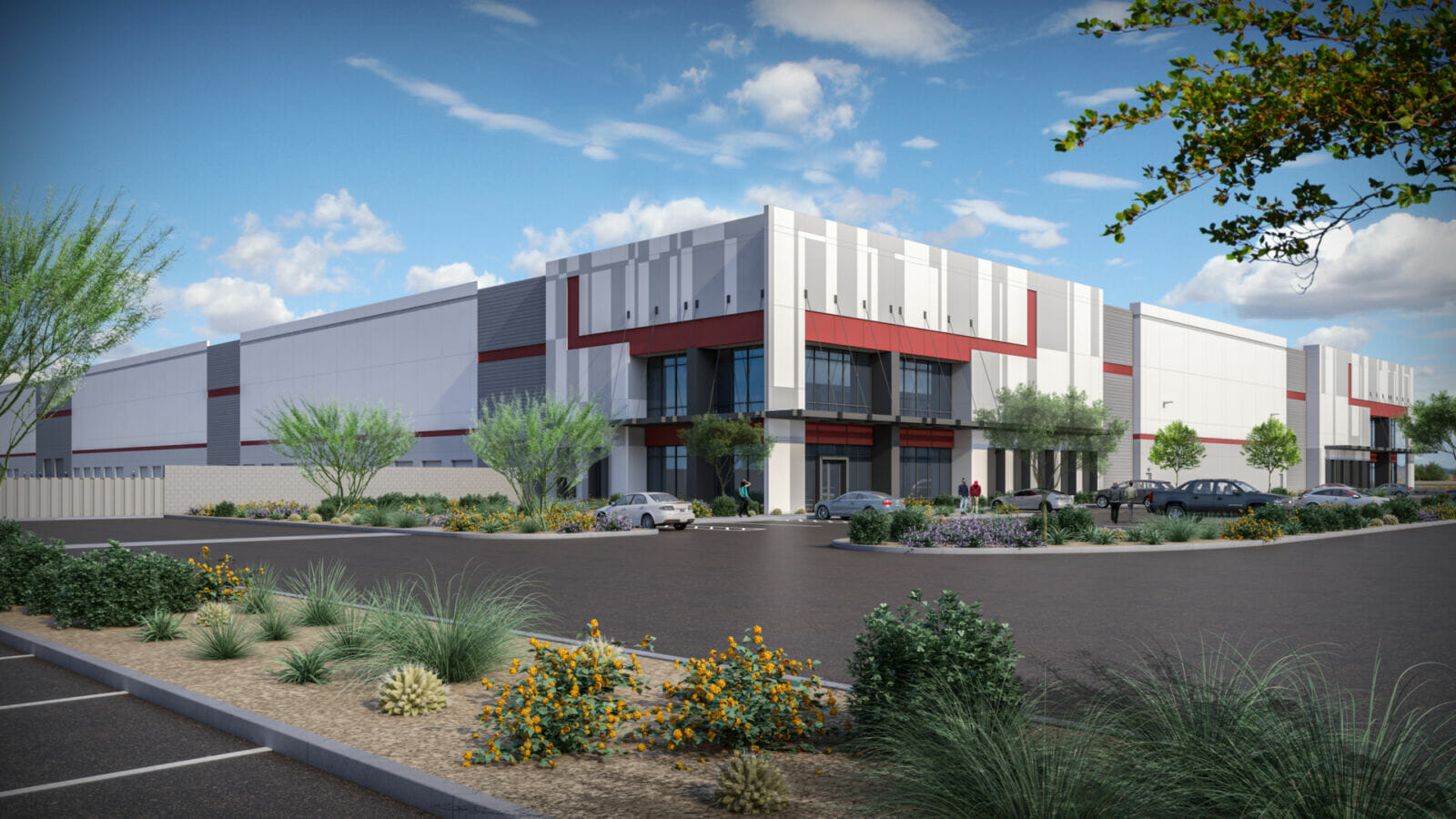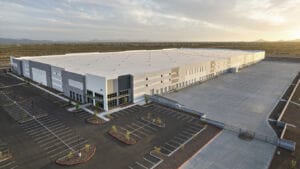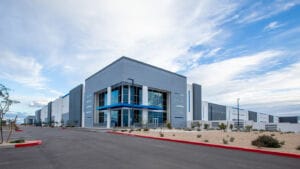The West Valley is amidst a renaissance of industrial activity, with millions of square feet of space coming out of the ground. Adding to this landscape is The Base, a new development in Glendale that will add nearly 2 million square feet of space to the market. The first phase of the project will include seven buildings ranging from 85,000 square feet to 309,000 square feet, for a total of 1,182,877 square feet. Phase 2 will bring an additional eight buildings spanning 41,000 square feet to 141,000 square feet in size, totaling 780,600 square feet.
Mark Krison, senior vice president at CBRE, explains that having 15 buildings of varying sizes allows for the development to best meet market demand. The average user, he says, requires anywhere from 85,000 to 105,000 square feet.
“The big buildings get all the press, but it’s the medium-sized ones that do all the leasing,” Mark Krison continues. “These buildings fit right in the middle of fairway for where most of the people want to be size wise. This product was designed to take advantage of the greatest menu of occupiers looking in the marketplace.”
There’s been a recent uptick in users associated with semiconductor operations looking for sub-200,000-square-foot spaces, adds Luke Krison, senior associate at CBRE. “Those manufacturing-centric users lend themselves to the types of buildings we’re constructing at The Base,” he says. “There’s a void in the market for this type of project and the size ranges.”
Features of The Base
Constructing multiple smaller facilities makes the layout of The Base more competitive in the highly active industrial market along the Loop 303, says Alex Boles, director of investments and development at ViaWest Group, even if it is more profitable to build fewer, yet larger products on site.
“When you look at Phoenix, CBRE reports there’s 35.2 million square feet [of industrial space] currently under construction. There are several one-million-square-foot buildings coming to the West Valley,” Boles continues. “I have to look at how I can compete with the big box bombers even though I’m further behind in terms of schedule. And that answer, to me, is this small product.”
The rental rates for smaller spaces tend to be higher, which helps offset the costs of bringing multiple structures to fruition. Moreover, The Base’s ability to cater to most users is a considerable asset. The 85,000-square-foot building, for example, has the capacity to support upwards of six tenants.
READ ALSO: Here’s why Metro Phoenix is on the way to becoming a Tier 1 market
“I’m looking to differentiate this project in a way that’s thoughtful,” Boles says. “I’m giving myself some flexibility on leasing up, but I’m still capitalizing on where I think the majority of the market momentum is for smaller businesses that want autonomy — in terms of building signage and being a sole tenant of the building. That’s the angle I’m going for.”
Not only do the buildings vary in total size, but also in dimension. Boles notes that users with an assembly line may not want the space to be as deep, whereas others that are racking inventory want more depth and the ability to cross dock.
“There’s going to be distribution and logistics guys that move out here,” Boles continues, “but I’m also catering to a small manufacturing or assembly company — which may have more high wage jobs for the submarket than what a typical logistics company would — with different building types and depths.”
Growing in Glendale
The Base will be located in Glendale, near Litchfield and Bethany Home Roads, only a few minutes away from both the Loop 303 and Northern Parkway. Greater Phoenix as a whole benefits from well thought out transportation infrastructure and proximity to major markets such as Southern California making the region an attractive option for distribution companies.
“Logistics is the name of the game,” Mark Krison says. “[These businesses] want to be as close as reasonably possible to a freeway backbone. This project has the Loop 303 on the west, Northern Parkway on the north, Interstate 10 to the south, and the Loop 101 going north up to the east. It’s in the middle of a square of freeways.”
Advanced manufacturing companies and suppliers of Taiwan Semiconductor Manufacturing Company’s (TSMC) chip plant in North Phoenix that want to be close by are also potential tenants, Mark Krison continues. Moreover, Boles notes that businesses in Southern California look to the West Valley as a viable alternative to the high costs associated with operating in the Inland Empire region.
“Southern California companies that grow can’t find a new home there because it’s simply more built out than we are,” Boles says. “So, they start looking elsewhere for a cheaper cost of business. The West Valley has turned into this bustling micro economy. It’s one of the most premier submarkets in all of Greater Phoenix.”
That said, the pace of industrial growth in the West Valley means that shovel ready sites are becoming scarcer, forcing developers to start looking at municipalities further west where some parcels lack adequate infrastructure.
“It’s hard to place a bet on a land site if you don’t have a 100% solution water, sewer and power — the very basic essentials to getting a tenant up and operable in an area,” Boles says. “As a developer I have to balance time to market — I need to know what my competition is going to be when I build these things — and I have to make sure that I can get the buildings online.”
Luke Krison agrees that turnkey options are harder to come by now.
“If we were in the market with a developer right now, and they said, ‘Luke, find me 50 acres. I want to develop buildings,’ the only options they’d have would be to find an off-market deal with a group that already owns real estate and overpay for the land,” he concludes. “The alternative would be to go further out west to Buckeye, and you would be presenting them very green options that feel like it’s pioneering the market because it just hasn’t gone that direction yet.”




